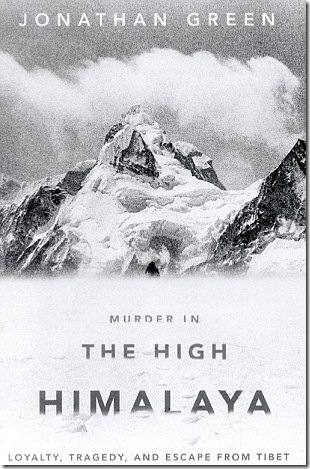Each year thousands of Tibetans attempt to flee their homeland by embarking on a perilous journey over snow-covered mountains. Some die along the way, and others are captured, jailed and tortured by Chinese soldiers.
Most often their plight receives little international attention. But the case of Kelsang Namtso, a 17-year-old nun, was different because mountain climbers witnessed Chinese soldiers fatally shooting her as she trudged through deep snow. Moreover, a cameraman captured the 2006 killing on tape.
Now Jonathan Green has meticulously reconstructed events surrounding Kelsang’s life and death. His well-written account will hook readers from the first page.
Murder in the High Himalaya successfully blends several story elements, including China’s brutal suppression of Tibet, the rising number of fame-seeking Western climbers determined to scale the world’s tallest mountain peaks, and the desperate flight of Tibetan men, women and children, first to Nepal and then to India, where they hope to meet the Dalai Lama, their beloved spiritual and temporal leader.
The Dalai Lama escaped to India nine years after the 1950 Chinese invasion of his homeland, and since then an estimated 100,000 Tibetans have followed him over the mountains. Green describes China’s campaign to wipe out Tibetan culture, including the destruction of 6,000 Buddhist monasteries and the torture and killing of dissidents, among them many monks and nuns. Possession of a picture of the Dalai Lama is a crime punishable by torture and imprisonment.
Chinese soldiers patrol the main escape routes in an effort to capture fleeing Tibetans, who pay huge sums to experienced guides who lead them through mountain passes.
Fleeing refugees suffer from frostbite, sunburn, snow blindness, blisters, hunger and thirst. Along the way they encounter corpses sticking out of the snow, a gruesome reminder that many do not reach their destination.
Green captures the incongruity of starving refugees dressed in rags fleeing past Western climbers in expensive gear getting ready to scale Mount Cho Oyu, a peak not far from Mount Everest.
The author criticizes what he calls an “age of egoism and commercialism” in mountain climbing, with its emphasis on “the individual as superman” seeking glory, book deals and speaking engagements. Green relates the heartbreaking story of a 16-year-old refugee who fell into a crevasse, where she screamed in panic. Nearby climbers had the necessary equipment to rescue her, but they “ignored her plight, and carried on up the mountain instead, leaving the girl to die.”
Seventeen-year-old Kelsang was part of a group of more than 70 Tibetans determined to escape through a 19,000-foot-high mountain pass. Some were wrapped in plastic sheets to ward off the cold, which frequently dropped well below zero. Those who could not endure the brutal conditions turned back.
Kelsang’s group was slowly pushing through the snow when Chinese soldiers opened fire with assault rifles. Kelsang plunged forward when a bullet tore into her back. Although scores of climbers were nearby, none intervened or offered to help, Green says. Moreover, most climbers agreed not to report the killing out of fear that China would bar them from future climbing on the Chinese side of the mountain.
Gradually, however, word leaked out. U.S. officials condemned the killing, which was recorded on video tape by a Romanian climber and later posted on YouTube, where it can still be viewed.
Of the more than 70 Tibetans in Kelsang’s group, 41 made it to Dharamsala, India, where they had an audience with their beloved Dalai Lama. One of the ironies, which Green could have explored in greater depth, is that about half of all refugees eventually return to Tibet, in part because life in India proves to be tougher than expected.
The book also could have included better maps, as well as a glossary of names. With so many unfamiliar Tibetan names, readers are forced to jump back and forth in the text to follow the story line.
As part of his research, Green started at border of Tibet and walked the path taken by the refugees through Nepal to India. He encountered paranoia everywhere. Many people refused to talk to him; others spoke only on condition that they not be named. Fear of offending the Chinese was rampant.
Despite the obstacles he encountered, Green has written an absorbing adventure story about a forbidding mountain range and a band of refugees who risked everything to reach the Dalai Lama, who continues to lead a campaign to publicize the plight of the Tibetan people.
Bill Williams is a freelance writer in West Hartford, Conn., and a former editorial writer for The Hartford Courant. He is a member of the National Book Critics Circle.
Murder in the High Himalaya: Loyalty, Tragedy, and Escape From Tibet, by Jonathan Green; 272 pp.;
PublicAffairs; $26.95
